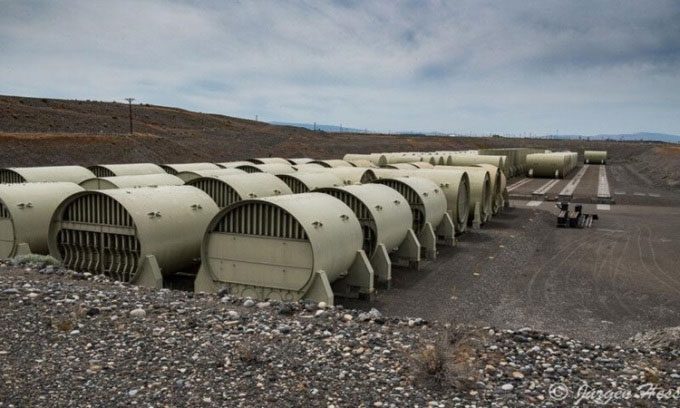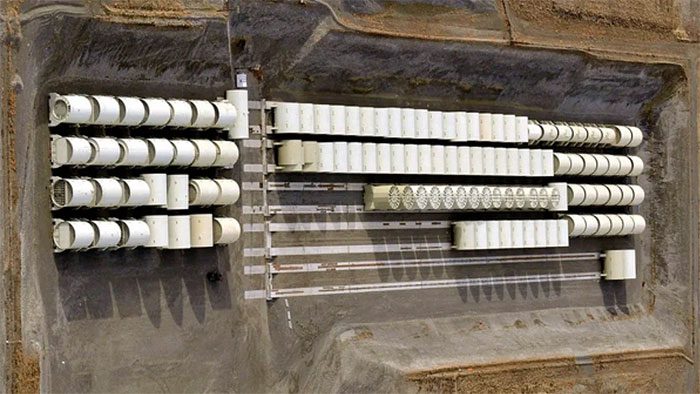Today, over 130 concrete containers holding hazardous radioactive material from decommissioned nuclear submarines are being stored in Trench 94.
The U.S. Navy has produced numerous nuclear submarines; however, once a submarine is decommissioned, its reactor must be transported to a storage site, which in this case is Hanford, a federal facility located in Washington State. Currently, more than 130 concrete containers, holding dangerous levels of radiation, are stored in Trench 94, and this number is expected to increase over the coming decades, according to Popular Mechanics.
The U.S. Navy established an area known as Trench 94, situated within the Hanford Site – a defunct nuclear production complex in eastern Washington State.
Trench 94 is approximately 300 meters long and serves as a storage site for all remnants of the reactors – substances that would be lethal to any living being that comes into proximity. This is why it has been ominously dubbed the “nuclear graveyard.”

Hazardous radioactive containers in Trench 94. (Photo: Jurgenhess Photography/Columbia Insight)
The dismantling process occurs at the Puget Sound Naval Shipyard in Bremerton, Washington. Subsequently, the neatly cut cylindrical “dry casks” undergo their final journey by ferry along the coastal region, across the Columbia River. They are dismantled at Benton Harbor and then transported by truck to Hanford. Hanford, managed by the U.S. Department of Energy, was established in 1943 to support the Manhattan Project. Hanford was the first plutonium production facility in the world, used for the Trinity test, the first nuclear explosion, and the Fat Man bomb dropped on Nagasaki, Japan.
Upon arrival at Hanford, the containers are transferred into Trench 94, an open trench measuring 305 meters long. According to Popular Mechanics, the entire “cask” process for the reactors at Trench 94 is as follows. First, when the reactors are decommissioned, they are cut into segments to remove the nuclear core and fuel.
While the fuel is sent to the Idaho National Laboratory, the remaining components, including the hull, the reactor’s lead shielding, heat-resistant alloys, and radiation-resistant materials – known as Inconel 600 – are dismantled.
According to the U.S. Navy, each reactor remains at approximately 25,000 curies of radiation at the time of dismantling. This level of radiation can kill an adult in mere seconds of exposure.
Due to the exceptionally dangerous nature towards living organisms and the environment, these reactors require particularly complex handling.

136 containers at the special facility within the Hanford Site, Washington, USA. (Photo: Getty).
As of now, there are 136 containers observable via Google Maps, each representing the remains of a nuclear submarine, neatly arranged in 5 rows. Known as “High Integrity Containers (HIC),” these containers are designed to hold the reactors for 300 years and withstand damage from a fall from 10 meters. According to the U.S. Navy, each reactor contains about 25,000 curies of radiation, enough to kill a person within seconds of exposure. The curie levels decrease over time due to radioactive decay, but each container still retains 250 curies after 1,000 years.
The number of containers in Trench 94 has gradually increased over the years as the U.S. Navy decommissions its first-generation nuclear submarines. The new containers come from the Los Angeles-class submarines being replaced by the newer Virginia class.
Consequences for Future Generations
The number of radioactive containers in Trench 94 has steadily increased in recent years as the Navy phases out its first-generation nuclear submarines.
The latest containers belong to decommissioned Los Angeles-class submarines, with the USS Enterprise soon to follow. By the end of this decade, Ohio-class submarines and Nimitz-class aircraft carriers will also face a similar fate.
It is estimated that within the next 20 years, Trench 94 will receive about 50 more containers.
This is the price of military power, often seen as the dark side of scientific advancement. For every vessel created, humanity must confront highly radioactive waste materials, particularly dangerous for over 1,000 years.
Currently, there are 6 countries that possess nuclear submarine fleets, including: Russia, the United States, the United Kingdom, France, China, and India.
However, over time, more countries will likely be added to this list. Alongside this, more nuclear submarines will be brought into service, which will create additional sites for storing decommissioned radioactive materials.
Some experts argue that the push for this technology has inadvertently created a burden for future generations, forcing them to face challenges they are ill-prepared to encounter.


















































